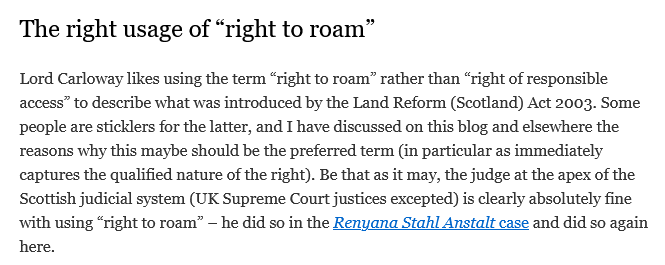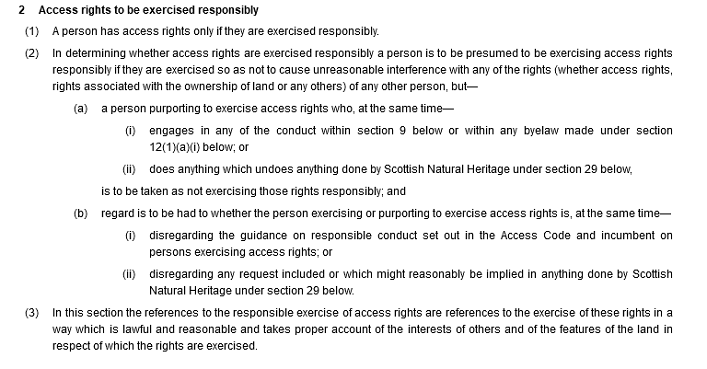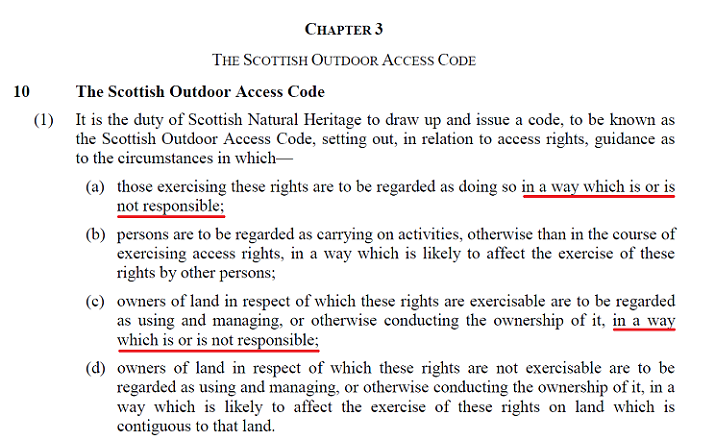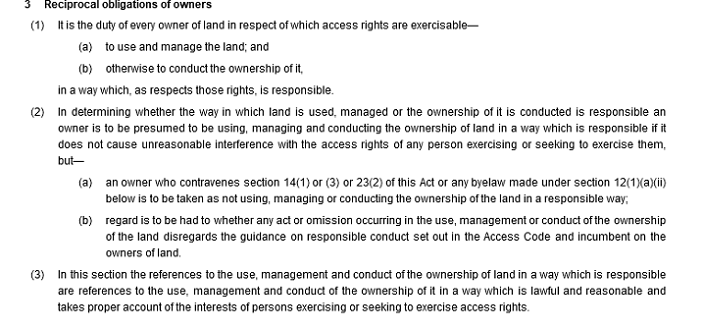On 20th December 2022, four and a half years after the Drumlean Case (see here), Lord Carloway and two other of Scotland’s most senior judges issued another judgement in the Court of Session (see here) which described access rights as “the right to roam”:
“[1] The Land Reform (Scotland) Act 2003 introduced new rights of public access to land. The new right comprises the right to be on land for recreational, educational and non-commercial purposes, and the right to cross land (s 1). This is known as the right to roam (see Anstalt v Loch Lomond & Trossachs National Park 2018 SC 406) [the Drumlean Case]. Access rights are restricted or prevented on specified parts of land; for example, land upon which a building is erected (s 6).
[2] Local and National Park authorities must uphold access rights (s 13). That includes devising a system of “core paths” to give the public reasonable access throughout their area (s 17). This is in addition to the general right to roam, which applies to many more paths and areas.
There was no mention of a “right of responsible access”, something which one of the proponents of that term grudgingly admitted on his blog (see here):

This post explains why Lord Carloway uses the term right to roam and what is wrong legally with the term “right of responsible access”. A further post will explain why it poses a threat to access rights.
The law
The Land Reform (Scotland) Act 2003 – whose 20th anniversary will be celebrated in a couple of weeks – secured and strengthened the customary freedom to roam in Scotland by establishing new statutory access rights:

The wording is important. Those rights are explicitly called “access rights”, not a “right of responsible access”.
Clause 1 sets out the two main qualifications to those access rights. The first is the right to be on (rather than cross) land must be exercised for one of the three purposes set out in sub-clause 3. The second is the reference in sub-clause to land which is excluded from access rights under section 6 of the Act:
![]()
That’s it. There is NO mention of responsibility in the foundational clause of the Act. What it says is that everyone who lives or visits Scotland has access rights, created by statute, not a “right of responsible access”. These access rights are what are commonly referred to as the right to roam, as acknowledged by Lord Carloway in his two judgements.
These access rights are then linked to two sets of responsibilities in Clauses 2 and 3, the first for members of the general public, the second for landowners:
 , It is this clause that authors like Malcolm Combe have used to argue that the right of access is qualified and would be better described as a “right of responsible access”. However, the emphasis in “Access rights to be exercised responsibly” puts access rights first, responsibility second. The claim this means the same as “a right of responsible access” switches the emphasis and puts responsibility first. It also cuts out the use of the word “exercise”, which is integral to the meaning of the law and used three times in sub-clause 3. A person exercises their access rights responsibly if they do so in a way that is a) lawful, b) reasonable, c) takes proper account of the interests of others and d) take proper account of the features of the land. That cannot be subsumed under the term “right of responsible access”.
, It is this clause that authors like Malcolm Combe have used to argue that the right of access is qualified and would be better described as a “right of responsible access”. However, the emphasis in “Access rights to be exercised responsibly” puts access rights first, responsibility second. The claim this means the same as “a right of responsible access” switches the emphasis and puts responsibility first. It also cuts out the use of the word “exercise”, which is integral to the meaning of the law and used three times in sub-clause 3. A person exercises their access rights responsibly if they do so in a way that is a) lawful, b) reasonable, c) takes proper account of the interests of others and d) take proper account of the features of the land. That cannot be subsumed under the term “right of responsible access”.
While the word “responsible” appears 14 times in the Act, the term “responsible access” is used not once, not even in Section 10 which required Scottish Natural Heritage to produce the Scottish Outdoor Access Code (SOAC):

While the term “responsible access” crept into the SOAC (mea culpa I was on the Board of SNH at the time it was developing the Code), it is only used four times. Two of those relate to landowners (e.g. where a landowner wants to promote responsible access). The term “responsible access” was therefore invented after the passing of Act and has since been developed further into “a right of responsible access”. Neither term reflects the law.
What is also important to note are the consequences of someone on land failing to exercise their access rights responsibly. They may then lose the statutory protection afforded by access rights – their legal right to be on land for stated purposes or to cross it – but their legal position then reverts to what it was before the Act was passed. To evict the person from their land a landowner would then have to seek an interdict in the courts, just like on land where access rights don’t apply unless another legal remedy happens to be available.
What this shows is that our statutory access rights are actually very strong. They provide people who want to visit or cross land additional legal security, a right to roam in common parlance. Legally this is completely different to what certain advocates of the “right of responsible access” would have people believe, that access rights are weak.
 Those who refer to “the right of responsible access” almost never refer to the reciprocal responsibilities of landowners. What is the equivalent phrase for them?
Those who refer to “the right of responsible access” almost never refer to the reciprocal responsibilities of landowners. What is the equivalent phrase for them?
In some ways the obligations on landowners created by the Act could be argued as being stronger than those of the general public, being expressed as a legal duty: “it is the duty of every owner of land…..”). However, sub-clause (3) (above) almost exactly mirrors the provisions placed on the general public (in Clause 2 (3) above). The two clauses interrelate and are mutually supporting; the general public must take account of the interests of landowners and landowners the interests of the general public.
The SOAC reflects this, balancing responsibilities of the public with responsibilities of land-owners. Two sets of responsibilities then, not one as implied by “a right of responsible access”.
What needs to happen?
The correct terminology when referring to the access rights of the general public is therefore “the right of access” or “the right to roam” and this applies over most land or water in Scotland. These are the terms that should be used by all public bodies in Scotland and any other organisations with an interest in access rights.
After my post on what is wrong with the term “access takers” I wrote to the National Access Forum asking them to discuss its use. Early in the New Year to receive a reply from Don Milton, the Convener (who also convener of the LLTNPA LAF). He has committed to discussing the term at the June meeting and meantime said he will recommend those involved in the NAF cease to use it. That is very positive. In the light of the latest endorsement of the term “right to roam” from Lord Carloway and the arguments set out here, I will now ask that the meeting also discusses the term “right of responsible access” with a view to it being removed from the access lexicon for the reasons set out in this post.
Source link
